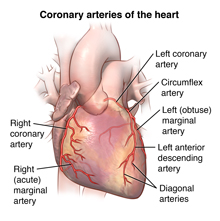Basic Anatomy of the Heart
Basic Anatomy of the Heart
About the heart
The heart is the hardest working muscle in the human body. The heart is located almost in the center of the chest. The adult human heart is about the size of a fist.
The heart beats at an average rate of 80 times a minute. That's about 115,000 times in one day, or about 42 million times in a year. In a 70-year lifetime, an average human heart will beat more than 2.5 billion times. The heart works hard even when you are at rest.
The average heart rate for children 10 years and older and adults is 60 to 100 beats per minute. In a well-trained athlete, the heart rate can be healthy at a rate of 40 to 60 beats per minute.
How the heart works
The cardiovascular system is made up of the heart and blood vessels. Its job is to circulate blood throughout your body. The blood brings oxygen and nutrients to the tissues.
The heart is made up of:
-
4 chambers (2 atria and 2 ventricles) that get blue (deoxygenated) blood from the body. They pump out red (oxygen-rich) blood back to it:
-
The atria get blood coming back to the heart.
-
The ventricles pump the blood out of the heart.
-
-
Blood vessels that include a network of arteries and veins that carry blood throughout the body:
-
Arteries carry blood from the heart to the body tissues.
-
Veins carry blood back to the heart.
-
-
4 valves to prevent backward flow of blood:
-
Each valve is meant to allow the forward flow of blood. It prevents backward flow.
-
-
An electrical system that serves as a natural pacemaker. It starts the contraction of the heart muscle.
Updated:
November 24, 2018
Reviewed By:
Glenn Gandelman MD MPH,Lu Cunningham,Lu Cunningham

